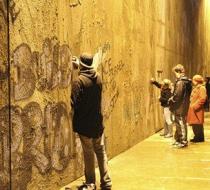Church protest reveals realities of life in modern Bethlehem Favorite
The Rev Lucy Winkett is having trouble sleeping. This is because her church on Piccadilly has decided to erect a full-size copy of the Israeli separation barrier to block off her Christopher Wren church. And because she lives above the shop, the grim presence of this temporary structure is with her all the time. "Politics aside, living beside the 26ft wall is having a curious effect on those who are here. It dominates our imagination and has colonised our minds – and ours is only an art installation up for the 12 days of Christmas," she told me and my 11-year-old son on a tour of the project.
It wasn't straightforward explaining the whole project to Felix. A few days after watching our church nativity play with him, it was quite an imaginative jolt to realise that Bethlehem is a real place cut off by a concrete wall and that it has very little in common with the fantasy, Narnia-like version that is the stuff of Christmas cards. I attempted to give him a potted version of the Palestinian-Israeli conflict, mindful that the sort of simplifications required to explain things to a young boy in half a minute were always going to fall into one trap or another. "So, whose side are you on, Dad?" he then asked. "Both," I replied. He was dissatisfied with that answer.
And that's the problem with the Israeli separation wall: it forces you to take sides.
Bethlehem Unwrapped at St James's Piccadilly
Focus on modern Bethlehem at St James's, Piccadilly, where a 26ft wall has has been built to replicate Israel's separation barrier.
The online reaction to this installation has also been predictably binary. For some it is a powerful testament to Israeli government brutality; for others it's another example of Christian antisemitism seeping into the liberal church. And some of the graffiti on the Piccadilly wall reflects this same for-us-or-against-us division. Some have written about its illegality under international law; others have written that this wall saves lives.
Personally, I think the separation barrier is a monstrosity that creates the feel of an open prison in places like Bethlehem and is sometimes more about a land grab by the Israeli authorities than it is about protection from Palestinian bombers. The idea, for instance, that the fence incorporates Jewish settlements such as Ariel, 12 miles into the West Bank, is evidence of its wider political role. But the line that says "this wall saves lives" cannot be dismissed out of hand.
Last week, a friend of mine was out shopping in Jaffa when I received a text notification that a bomb had been discovered on a bus in southern Tel Aviv, not far away. In the end, it was disarmed, but one security man was hurt. The intention to create carnage on that bus was clear. And if these buses carry people you know and love, you will see things differently. During the first three years after the beginnings of the second intifada in September 2000, suicide attacks on Israeli citizens rose steeply: more than 200 people were killed in 2002. As the wall was constructed, so the numbers declined: only three people were killed by suicide bombers in 2007. It is possible to dispute the fact that there is a causal link here, but the numerical evidence is not insignificant.
I know the familiar joke about the Anglican church sitting on the fence so much that it has splinters in its bum, but I admire the fact that places like St James's in Piccadilly are prepared to speak about the multiple injustices created by the wall without succumbing to some nonsense about whose side are you on. That's cheap sloganeering politics, too concerned with maintaining the purity of its own outrage.
But even worse than this is the fantasy of Bethlehem as some religious Disneyland. O little town of Bethlehem, how still we see thee lie – lie being the operative word there.
Source: http://www.theguardian.com/commentisfree/belief/2013/dec/27/church-prote...







